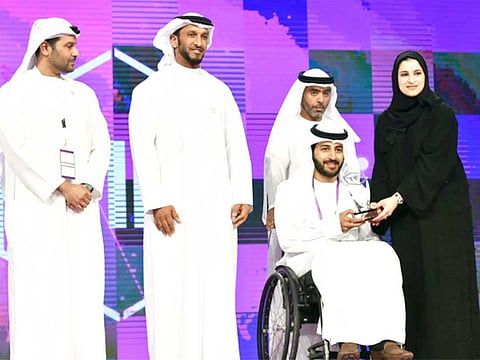Dh3 million awards to support game-changing medical patents
Innovations include new antibiotic compounds, catheter devices and systems to correct ear defects

Abu Dhabi: A new class of antibiotic compounds, a device to correct an ear defect that affects 300 million people and a new catheter that is safer and easier to use were some of the 23 projects for which patents were announced in the capital on Wednesday.
The patents were announced during the Technology and Innovation Pioneers (TIP) Healthcare Awards, an annual prize that seeks to recognise innovation in the health care sector. A total of Dh3 million will be distributed among the winners, who presented ideas for patents, proofs of concept and start-up purposes, in this first cycle of the awards.
“This is really exciting because what we are seeing here today are game-changers. Can you imagine the development of a new class of antibiotics that is effective against multidrug resistant bacteria? It would come at a time when the whole world is grappling with antibiotic resistance, and that too from the UAE,” said Dr Asma Al Mannaei, director of health care quality at the Abu Dhabi Department of Health (DOH), told Gulf News.
“Or consider the market-disruptive patent for the device which corrects an ear defect affecting five per cent of the world’s population. All of this is unprecedented in the UAE, and would change health care across the world,” she added.
The TIP Healthcare Awards were organised by the Abu Dhabi Department of Economic Development in collaboration with the health department. The awardees included Emiratis, resident researchers, a number of international applicants, and even an Emirati with special needs. The exact value of each grant was not announced however.
Notable winners
Antibiotic compounds
■ Dr Taleb Al Tel, team leader for novel antibiotics project at University of Sharjah.
“We’ve discovered a group of compounds that are more effective at killing multi-drug resistant bacteria than many of the currently available antibiotics.
Not only do they kill the bacteria faster but small quantities of these compounds are 10 to 20 times potent than many other broad-spectrum antibiotics. We now need to partner with investors and get these to clinical trials. If all goes well, the antibiotics, developed in the UAE, should be ready for the market in three years.”
Catheter device
■ Ahmad Al Hammadi, Emirati developer of hydrophilic catheter
“Conventional catheters are difficult to insert, and their use results in many infections because it is difficult to keep the tubing clean.
I’ve designed a catheter in which the tubing is encased with polyvinyl chloride, which means that the tube can be kept hygienic. I believe this will ease the lives of patients who must use catheters on a daily basis, including patients with paralysis and spinal cord injuries.”
Eustachian tube device
■ Dr Tarik Ozkul, founder of Turkey-based innovative solutions developer, Strategic Innovative Initatives
“More than 300 million people worldwide suffer from Eustachian tube dysfunction, a terribly painful ear condition in which the Eustachian tube that is responsible for equalising pressure in the ear fails to open up.
Conventional therapies use invasive means to open the tube but they can increase the risks of infection. We’ve discovered, for the first time, that the condition is caused because two sets of brain signals to open the tube become unsynchronised, and have developed a device to deliver electronic impulses to synchronise them. We’ve finished one set of clinical trials already, and need to complete one more set before the device is market ready.”
Tooth isolation device
■ Dr Wafa Al Beloushi, Emirati developer of medical device for tooth isolation and medical resident
“Root canals use multiple metal clamps and tools to isolate the tooth that needs to be treated, and dentists must use anaesthetics to numb the gums so that the clamps can be secured. Sometimes, these clamps irritate the gums, and all of this makes root canals painful and time-consuming.
I have developed a rubber device that can be secured easily. It will quickly help isolate the tooth that needs to be treated and because it doesn’t have metal grips, it won’t irritate the gums. I’ve already contacted a company to develop the products, and hope to have it ready for the market in a year’s time.”
Cancer therapy
■ Dr Ghaleb Hussaini, primary investigator in nanomedicine and ultrasound cancer therapy project at American University of Sharjah, and associate dean of graduate affairs and research
“Under conventional chemotherapy, drugs spread throughout the body, acting upon and killing all kinds of fast-growing cells. This means that hair follicle cells, cells in the stomach linings, and white blood cells also get affected in addition to cancer cells.
Our multimodal treatment encapsulates the drugs in a lipid capsule with a target that specifically identifies biomarkers on cancer cells. Once the drugs are injected, they look for the biomarkers and gather around the cancer cells. We then apply an ultrasound to open up the lipid capsule and release the drug only at the targeted site. Our project is still in the pre-clinical stage, but should be market-ready in five to seven years.”
Sign up for the Daily Briefing
Get the latest news and updates straight to your inbox



